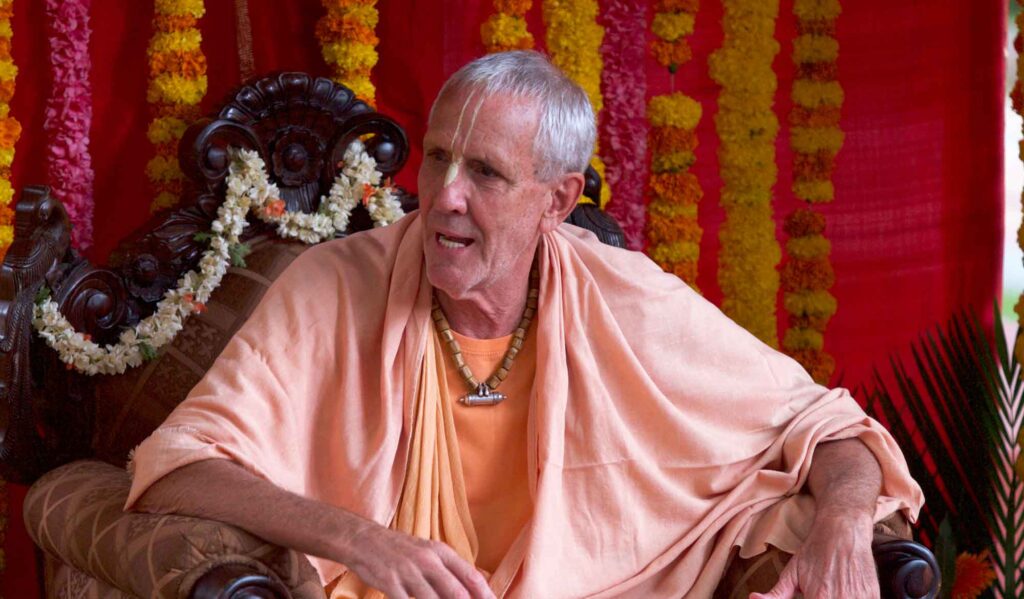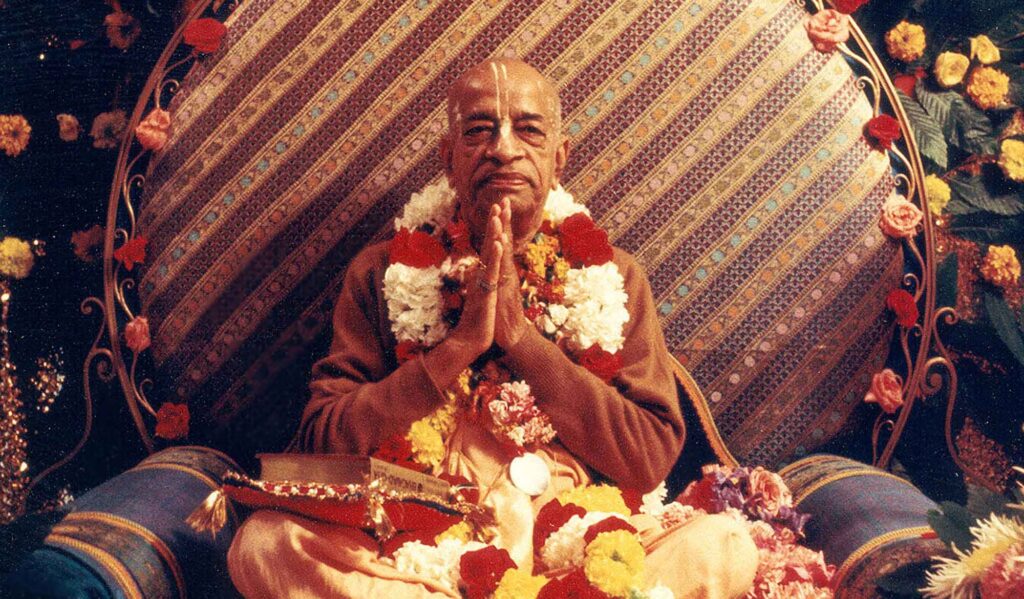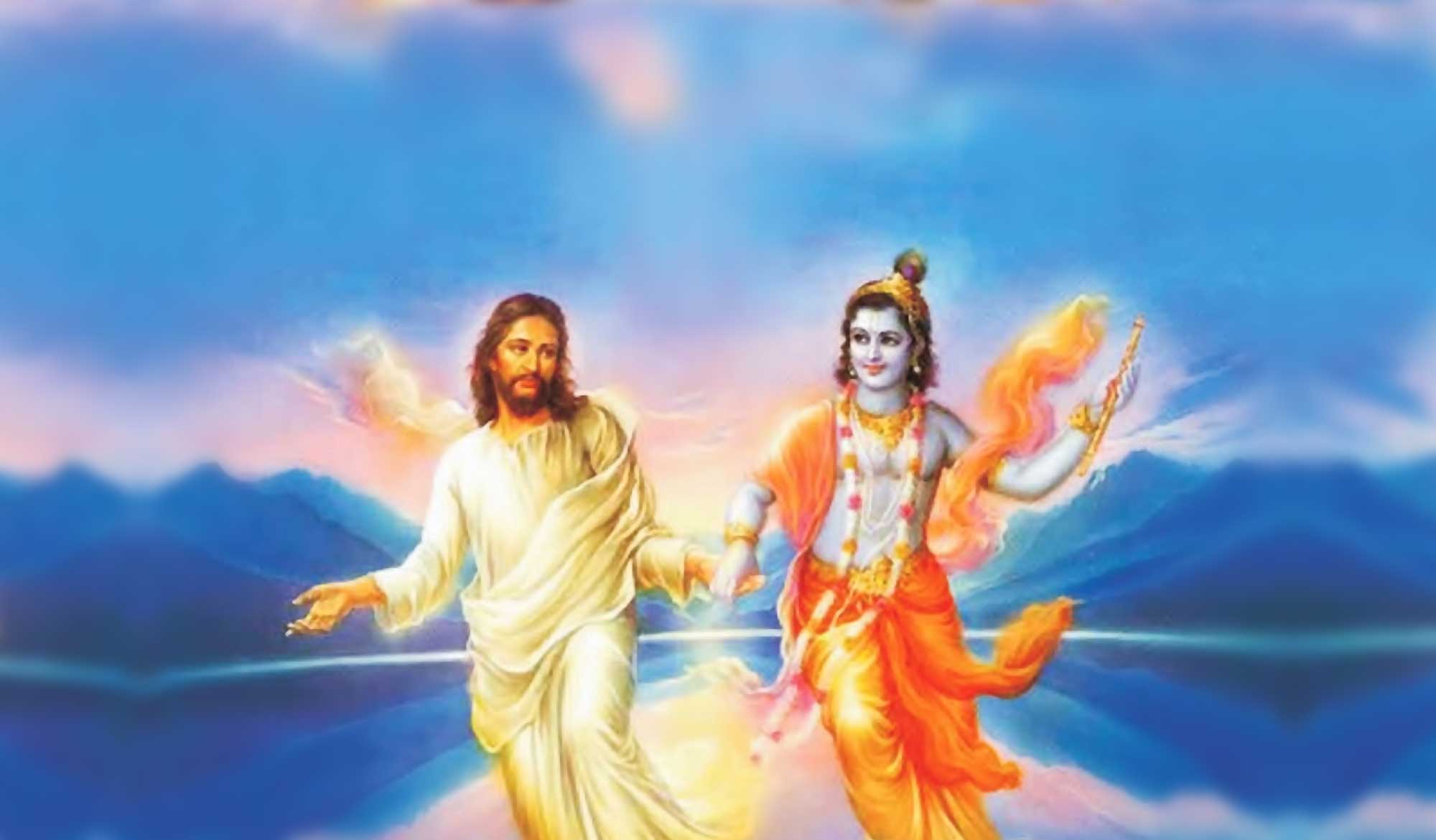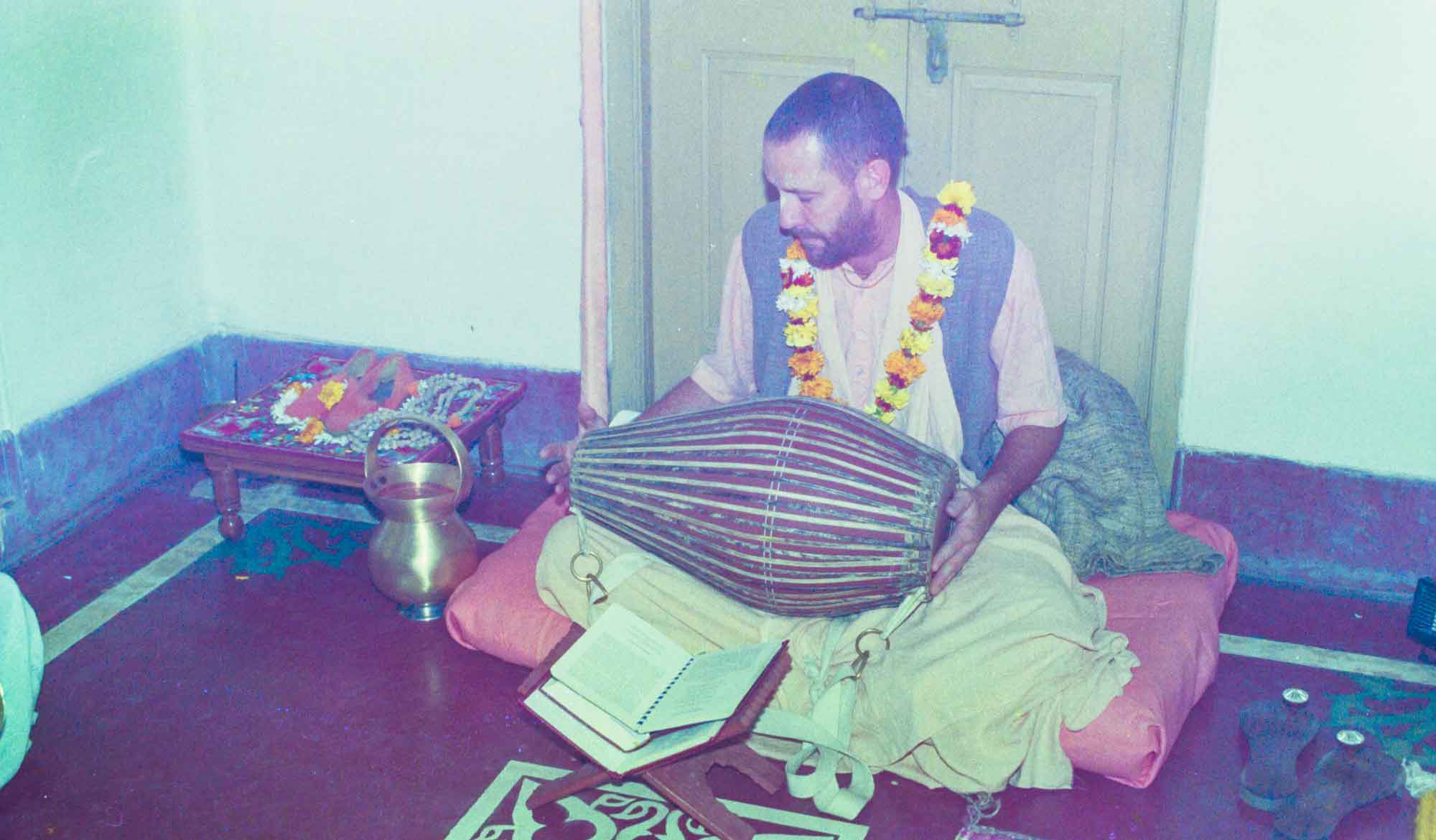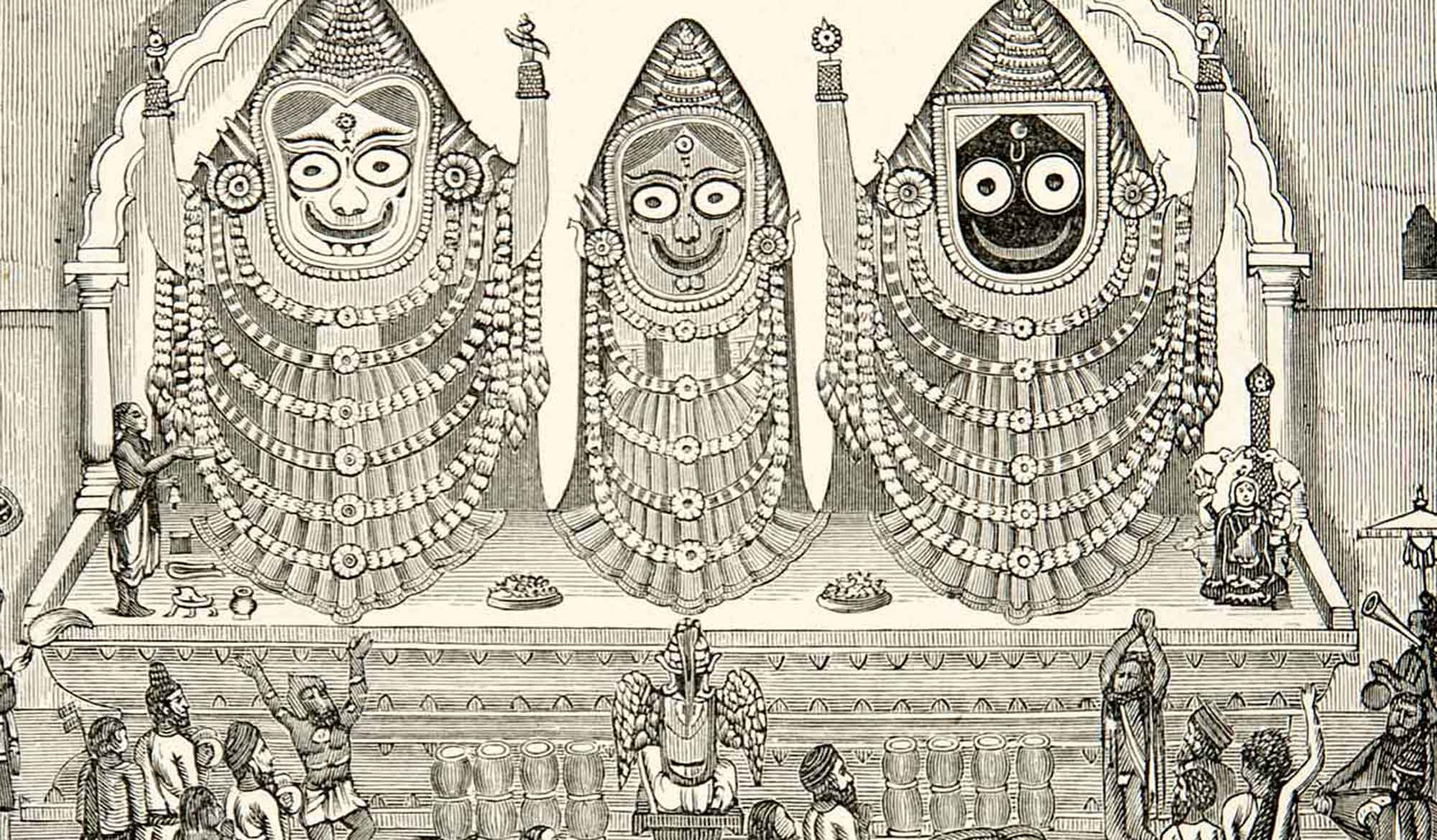by Swami B.G. Narasingha
"My Dīkṣā & śikṣā-Gurus'" was written by Swami B.G. Narasingha in June 2018. In this article, Narasingha Maharaja explains his connection to his three gurus - Śrīla A.C. Bhaktivedānta Swami Prabhupāda, Śrīla B.R. Śrīdhara Mahārāja and Śrīla B.P. Purī Mahārāja.
Question: Narasiṅgha Mahārāja has on numerous occasions made the following statement:
“I received hari-nāma from Śrīla B.P. Purī Mahārāja, gāyatrī from Śrīla B.R. Śrīdhara Mahārāja and sannyāsa from Śrīla Prabhupāda (A.C. Bhaktivedānta Swami Prabhupāda).”
Of course, we all know that Narasiṅgha Mahārāja received all three of his initiations, hari-nāma, gāyatrī and sannyāsa, from A.C. Bhaktivedānta Swami Prabhupāda, but we also know that Narasiṅgha Mahārāja received śikṣā between 1986 and 1988 from Śrīla B.R. Śrīdhara Mahārāja, and from Śrīla B.P. Purī Mahārāja between 1994 and 1999. It should also be clear that Narasiṅgha Mahārāja never received any sort of re-initiation from either of his śikṣā-gurus. So what does Narasiṅgha Mahārāja mean when he says, “I received hari-nāma from Śrīla B.P. Purī Mahārāja, gāyatrī from Śrīla B.R. Śrīdhara Mahārāja and sannyāsa from Śrīla Prabhupāda”?
Answer: Narasiṅgha Mahārāja briefly explains as follows:
brahmāṇḍa brahmite kono bhāgyavān jīva
guru kṛṣṇa kṛpa pāya bhakti-latā-bīja
“According to their karma, all living entities are wandering throughout the entire universe. Some of them are being elevated to the upper planetary systems, and some are going down into the lower planetary systems. Out of many millions of wandering living entities, one who is very fortunate gets an opportunity to associate with a bona-fide spiritual master by the grace of Kṛṣṇa. By the mercy of both Kṛṣṇa and the spiritual master, such a person receives the seed of the creeper of devotional service.”
The spiritual master, the representative or manifestation of the caitya-guru, Paramātmā, appears before the fortunate living entity as the dīkṣā-guru (initiating spiritual master) and the śikṣā-guru (instructing spiritual master). Both the dīkṣā and śikṣā-guru are to be understood as equal manifestations of the Supreme Personality of Godhead.
guru kṛṣṇa-rūpa hana śāstrera pramāṇe
guru-rūpe kṛṣṇa kṛpā karena bhakta-gaṇe
“According to the evidence of the scriptures, the spiritual master is non-different from Kṛṣṇa. Lord Kṛṣṇa. In the form of the spiritual master, shows compassion to His devotees.” (Cc. Ādi 1.45)
ācāryaṁ māṁ vijānīyān nāvamanyeta karhicit
na martya-buddhyāsūyeta sarva-deva-mayo guruḥ
“One should know the ācārya as Myself and never disrespect him in any way. One should not envy him, thinking him an ordinary man, for he is the representative of all the demigods.” (Cc. Ādi 1.46 from Bhāg.11.17.27)
śikṣā-guruke ta’ jāni kṛṣṇera svarūpa
antaryāmī, bhakta-śreṣṭha, — ei dui rūpa
“One should know that the instructing spiritual master is non-different from Kṛṣṇa and manifests two forms – as the Supersoul and as the greatest devotee of the Lord.” (Cc. Ādi.1.47)
There are two types of śikṣā-gurus, or instructing spiritual masters. One teaches by example and the other teaches by relevant instructions. Śrīla Prabhupāda explains in the purport to the above verse as follows:
“There are two kinds of instructing spiritual masters. One is the liberated person fully absorbed in meditation in devotional service, and the other is he who invokes the disciple’s spiritual consciousness by means of relevant instructions. Thus the instructions in the science of devotion are differentiated in terms of the objective and subjective ways of understanding…There is no difference between the shelter-giving Supreme Lord and the initiating and instructing spiritual masters. If one foolishly discriminates between them, he commits an offence in the discharge of devotional service.”
In other words, one type of śikṣā-guru instructs us objectively by his example, and the other instructs us subjectively by his relevant instructions. Both these śikṣā-gurus are to be understood as personal representatives of Śrī Govinda, whereas the dīkṣā-guru is a personal manifestation of Madana-mohana. This is confirmed by Śrīla Prabhupāda as follows:
“The initiating spiritual master is a personal manifestation of Śrīla Madana-mohana vigraha, whereas the instructing spiritual master is a personal representative of Śrīla Govindadeva vigraha.” (Cc. Ādi 1.47 Purport)
Śrīla A.C. Bhaktivedānta Svami Prabhupāda
Having received hari-nāma-dīkṣā, gāyatrī-dīkṣā and the renounced order of life (sannyāsa) from that great personality, Śrīla A.C. Bhaktivedānta Svami Prabhupāda, I can never fully express my indebtedness to His Divine Grace, even if I were endowed with the prolonged life of Lord Brahmā. Only by the mercy of His Divine Grace, the śaktyāvesa-avatāra of Śrī Nityānanda Prabhu, do I know anything regarding the science of Kṛṣṇa consciousness.
guruvajñaṁ śīrasi-dhāryaṁ śaktyaveśa-svarūpine
hare kṛṣṇeti-mantrena pāścatya-prācya tāriṇe
“Taking the order of his guru upon his head, he became empowered by Nityānanda Prabhu to act as a śaktyāvesa-avatāra. He distributed the Hare Kṛṣṇa mantra all over the eastern and western world, delivering and uplifting all fallen souls.” (composed by Bhakti Sundara Govinda Mahārāja)
Śrīla Prabhupāda is remembered as being the eternal servant of Śrīla Bhaktisiddhānta Sarasvatī Ṭhākura, who instructed Śrīla Prabhupāda to preach in English and to print and distribute Kṛṣṇa conscious literature. His Divine Grace dedicated his life to fulfilling the instructions of his guru and passed those instructions on to his disciples.
rādhā-kuṇḍa taṭāṅgane, ati antaraṅga sthāne
ela tāṅra sāndra premāveśa
gāḍha anurāga-mane, sarva-ātma nivedane
māthe tule-nilā gurvādeśa
“In the most intimate place of the mādhurya pastimes, namely Śrī Rādhā-kuṇḍa, His Divine Grace experienced the full ecstasy of kṛṣṇa-prema. Whole-heartedly surrendering unto Śrīla Bhaktisiddhānta Sarasvatī Ṭhākura with intense love His Divine Grace received upon his head the most holy order of his Gurudeva, “If you ever get money print and distribute books.” (Śrīla Prabhupāda Līlā-Smaraṇa Maṅgala Stotram 10)
As per the order of his Guru Mahārāja, Śrīla Prabhupāda engaged us in the saṅkīrtana movement and distributing Kṛṣṇa conscious literature worldwide. He often expressed his appreciation for his disciples doing so, as is referenced in the following letter:
“You are doing so much for fulfilling the desire of my Spiritual Master so you are indirectly the representative of my Guru Mahārāja. He has been helping me in this matter by sending so many young boys and girls, otherwise who would help me in this mission while I came here empty handed and without any friend. I can only pray to Kṛṣṇa to take care of you, otherwise I cannot repay your sincere service in my mission.” (22nd February 1970 – letter to Bali-mardana)
On the occasion of receiving sannyāsa from Śrīla Prabhupāda on Gaura Purnima day 1976, His Divine Grace ordered me to preach the saṅkīrtana movement of Śrī Caitanya Mahaprabhu in every town and village as a parivrājaka, a traveling mendicant. In a letter the following year His Divine Grace blessed me with the following words:
“You are a very nice sannyāsī, and expert in this kind of preaching, so I have faith that you will be able to do effective work to spread this movement for everyone’s benefit.” (31st January, 1977 – Letter to Jagat-guru Swami)
Those words of His Divine Grace have encouraged me throughout, and sustained me through otherwise insurmountable difficulties. Apart from the fathomless ocean of divine instructions given by Śrīla Prabhupāda personally, thru his letters and in the Bhaktivedānta Purports, his instruction given just a few weeks before his departure from this world in 1977 in Vṛndāvana, to seek guidance from his godbrother, Svami B.R. Śrīdhara Mahārāja in Navadvīpa, was second to none – “If you have questions regarding philosophy (Gauḍīya siddhānta) you may go to my godbrother, B.R. Śrīdhara Mahārāja at Navadvīpa.”
At that very moment my godbrother, Svami B.V. Tripurāri Mahārāja was massaging Śrīla Prabhupāda’s lotus feet. It was ten years later (1987) that Śrīpāda Tripurāri Mahārāja encouraged me to journey to Navadvīpa to personally take shelter of the śikṣā and lotus feet of Śrīla Śrīdhara Mahārāja. And it was the following year that Śrīla Śrīdhara Mahārāja conferred his full mercy upon me, naming me ‘Bhakti Gaurava Narasiṅgha’ and instilling the verse, “matala hari-jana viṣaya raṅge, pūjala rāga-patha gaurava-bhaṅge” into the deepest recesses of my heart. Indeed, the very name given to me, ‘Gaurava’, was derived from this verse:
matala hari-jana viṣaya raṅge
pūjala rāga-patha gaurava-bhaṅge
“The path of divine love is worshipable to us and should be held overhead as our highest aspiration.”
It is said by Śrīla Prabhupāda’s disciples that His Divine Grace gave us everything. Therefore, it should be remembered that His Divine Grace gave us Śrīla Śrīdhara Mahārāja. About the transcendental qualifications of Śrīla Śrīdhara Mahārāja there should be no doubts. Śrīla Prabhupāda stated in a letter to his disciple Hṛṣīkeśa Dāsa that His Divine Grace considered Śrīla Śrīdhara Mahārāja to be his śikṣā-guru. It is also certainly worth remembering here that not just anyone could be the śikṣā-guru of A.C. Bhaktivedānta Swami Prabhupāda without being transcendentally situated in the highest order of the rūpānuga-sampradāya. In a letter to his disciple Hṛṣīkeśa Dāsa, Śrīla Prabhupāda wrote as follows:
“So if you are actually serious to take instructions from a śikṣā-guru, I can refer you to one who is most highly competent of all my god-brothers. This is B.R. Śrīdhara Mahārāja, whom I consider to be even my śikṣā-guru, so what to speak of the benefit that you can have from his association.” (31st, January, 1969)
In 1967 when Śrīla Prabhupāda and a few of his disciples were attending the Vyāsa-pūjā celebrations of Śrīla Śrīdhara Mahārāja at Śrī Caitanya Sārasvata Maṭha he wrote the following:
“Yesterday we have all come to Navadvipa. This place is another establishment of one of my godbrothers. It is very nice and extensive place and my God-brother, B.R. Śrīdhara Mahārāja has spared one entire nice house for my stay. He has also agreed to cooperate with our society. We shall observe his birthday ceremony tomorrow and the brahmacārīs shall learn how to celebrate the spiritual master’s birthday.” (26th October, 1967 – Letter to Satsvarūpa Dāsa)
During Śrīla Prabhupāda’s stay at Śrīdhara Mahārāja’s āśrama, our godbbrother, Acyutānanda Prabhu observed Prabhupāda and Śrīdhara Mahārāja fully absorbed in a deep discussion in Bengali. When Acyutānanda asked about the nature of their talk Śrīla Prabhupāda replied, “If I were to tell you, you would faint. Śrīdhara Mahārāja has very high realisations.” (Prabhupāda-līlāmṛta, Vol. 3. p.205)
There are many such references that validate the elevated position of Śrīla Śrīdhara Mahārāja and not least of all the following statement by Śrīla Bhaktisiddhānta Sarasvatī Ṭhākura showing his great appreciation for Śrīla Śrīdhara Mahārāja’s composition “Bhaktivinoda Virāha Dvādaśakam,” a poem glorifying the position of Śrīla Bhaktivinoda Ṭhākura:
“Bhaktivinoda Ṭhākura himself has written this (poem) through him (Śrīdhara Mahārāja). Now I am satisfied that after me what I came to say, that will stay, that will remain; I find in these ślokas the (proper Gauḍīya) siddhānta.”
The Śikṣā of Śrīla B.R. Śrīdhara Deva Gosvami Mahārāja
The śikṣā of Śrīla Śrīdhara Mahārāja is none other than that of the Divine Preceptors of the line of Śrī Rupa Gosvami known as the rūpānuga-varga. So much so, that each and every word emanating from his lotus mouth was a gem of Gauḍīya siddhānta, his numerous writings are indeed testimony to that.
The words of Śrīla Śrīdhara Mahārāja, both on audio tapes and in book format, are perhaps one of the greatest theological treasures amassed in the 20th Century. When the transcendental vibration from his lips enters the heart of a sincere seeker of truth, one immediately feels the fulfilment of the innermost hankering of the heart – we want Kṛṣṇa and nothing else.
To compile the complete list of Śrīla Śrīdhara Mahārāja’s glorious śikṣā is not possible. However, at the top of the list we present Śrīla Śrīdhara Mahārāja’s commentary on brahma-gāyatrī known as Śrī gāyatrī-nigūḍhārtha. This commentary is the definitive commentary on brahma-gāyatrī extolling the siddhānta of the Gauḍīya Vaiṣṇavas in the line of Śrī Rūpa Gosvāmī leading us to rādhā-dāsyam, the exclusive service of Śrīmati Rādhārāṇī. This crest-gem among Gauḍīya commentaries enters the heart and establishes the worship of Śrīmatī Rādhārāṇī as life’s ultimate goal. Therefore, I say with folded hands that, “I have received gāyatrī from Śrīla Śrīdhara Mahārāja”.
Śrī gāyatrī-nigūḍhārtha, the illustrious commentary on the brahma-gāyatrī in the line of Śrīmad Bhāgavatam, is presented here:
bhvādes-tat savitur-vareṇya-vihitaṁ kṣetra-jña-sevyārthakaṁ
bhargo vai vṛṣabhānu-jātmā-vibhavaikārādhanā śrī-puram
bhargo jyotir-acintya-līlana-sudhaikārādhanā śrī-puram
bhargo dhāma-taraṅga-khelana-sudhaikārādhanā śrī-puram
bhargo dhāma-sadā nirasta kuhakaṁ prajñāna-līlā-puram
devasyāmṛta-rūpa-līla-rasadherārādha-dhīḥ-preriṇaḥ
devasyāmṛta-rūpa-līla-purṣasy-ārādha-dhī preṣiṇaḥ
devasya-dyuti-sundaraika-puruṣasy-ārādhya-dhī-preṣiṇaḥ
gāyatrī-muralīṣṭa-kīrtana-dhanaṁ rādhā-padaṁ dhīmahi
gāyatrī-gaditaṁ mahāprabhu-mataṁ rādhā-padaṁ dhīmahi
dhīr-ārādhanam eva nānyad-iti-tad-rādhā-padaṁ dhīmahi
“With all of your thoughts and heart’s desire, fully engage yourself in the pure devotional service and worship of bhargo, the supreme goddess Śrīmatī Rādhārāṇī, who is the unlimited origin and possessor of the svarūpa–śakti of Kṛṣṇa, the Supreme Beautiful Godhead (deva). Being the ultimate and all harmonizing potency of Kṛṣṇa, She remains His eternally unexcelled beloved servitor. In order to fully enrich and promote His līlā–vilāsa, She manifests Herself in variegated congenial forms. It is She Who manifests Herself as dhāma (Goloka) the abode of Kṛṣṇa, in the form of beautiful effulgence (saundarya–jyoti) and opulence (vaibhava), adorning and glorifying Him all around. It is She who extends Herself as līlā–śakti (the potency principle which promotes the bliss giving pastimes of Śrī Kṛṣṇa in variegated colourful, tasteful, mystically opulent and beautiful ways). She is the unlimited ocean of love of Kṛṣṇa personified (mahā-bhāva-svarūpinī). Therefore, adore Her as the supreme goal of life, Who gives venerable, blessed intelligence, realization and taste of enhanced loving worship towards Her and Her eternal beloved deva, Śrī Kṛṣṇa, the all fulfilment of life. The sound of gāyatrī is none other than the divine flute song of Kṛṣṇa. This flute song is naturally filled with rādhā–prema and dedicated to serve pleasure unto Her. What is the special characteristic of this all-attractive flute song in the life of devotional aspirants? It deeply attracts all souls to the unending beauty, glories and qualities of His eternal beloved Śrīmatī Rādhārāṇī, and situates them correctly in their own respective positions in Her eternal ecstatic service. Kṛṣṇa’s flute song thus deeply inspires the devotees to embrace an artist-servitor in the divine service-concert of His eternal consort Śrīmatī Rādhārāṇī through harmonious service performance. The innermost meaning of this flute song for all devotees is rādhā-padaṁ dhīmahi which means to wholeheartedly embrace and engage yourself in the service of the lotus feet of Śrīmatī Rādhārāṇī with all devotional love. The highest and innermost instruction of Śrī Caitanya Mahāprabhu rādhā-padaṁ dhīmahi.”
The Śikṣā of Śrīla Bhakti Pramoda Purī Mahārāja
The pure devotees of Kṛṣṇa are the reservoir of all good qualities, but the crest jewel of those qualities is humility. Only those devotees who have developed the quality of humility can constantly chant the holy name of Kṛṣṇa.
tṛṇād api su-nīcena taror iva sahiṣṇunā
amāninā māna-dena kīrtanīyaḥ sadā hariḥ
“One can chant the holy name of the Lord in a humble state of mind, thinking himself lower that the straw in the street. One should be more tolerant than the tree, devoid of all sense of false prestige and ready to offer all respects to others. In such a state of mind one can chant the holy name of Kṛṣṇa constantly.” (Śikṣāṣṭaka 3)
Once, in the time of our Guru Mahārāja’s gṛhastha-līlā as a pharmacist, he was asked by a godbrother if he had a formula for the disease of material consciousness. Much to that godbrother’s surprise, our Guru Mahārāja answered that yes, he had a formula, but that he was unable to put it into a bottle. When asked what that formula was, our Guru Mahārāja quoted the third verse of the Śikṣāṣṭaka.
Indeed, the ahaṅkāra (false ego) that binds the conditioned soul to the cycle of endless birth and death is crushed by one who chants the holy name of Kṛṣṇa with the humility described in the third verse of Śikṣāṣṭaka, tṛṇād api su-nīcena taror iva sahiṣṇunā. This Vaiṣṇava humility is so profound that it is all-attractive, even to the Lord Himself. The heart of Kṛṣṇa is filled with love for such Vaiṣṇavas.
ahaṅkāra-nivṛttanam keśavo nāhi duragaḥ
ahaṅkāra-yutanam hi madhye parvata-rāśayaḥ
“Keśava (Kṛṣṇa) is not far from those who are free from false-ego. However, there are mountains between Him and those who are infested with false-ego.” (Brahma-vaivarta Purāṇa)
nāhaṁ tiṣṭhāmi vaikuṇṭhe yogināṁ hṛdayeṣu vā
tatra tiṣṭhāmi nārada yatra gāyanti mad-bhaktāḥ
“I am not in Vaikuṇṭha, nor in the hearts of the yogīs. I remain where My devotees engage in glorifying My activities and chanting My name. (Padma Purāṇa)
It has been observed by many Vaiṣṇavas, both aspiring and advanced, that Śrīla Bhakti Pramoda Purī Mahārāja was the abode of Vaiṣṇava humility, winning the heart of Kṛṣṇa and the affections of all those who came in contact with him. Many times we saw the demonstration of Śrīla Purī Mahārāja’s humility and on such occasions it left us utterly speechless.
Finding a place in the heart of Kṛṣṇa, it has also been observed that Śrīla Purī Mahārāja’s affectionate relationship with Kṛṣṇa was much like that of Śrī Uddhava, as indicated in the last two lines of Śrīla Purī Mahārāja’s praṇāma-mantra:
yathoddhavasya-kumārād bhagavadārccane rati
vaiṣṇavānām sarva kṛtye dakṣatā paramā tathā
“Unto he who is forever vigilant in both the practice and preaching of bhagavata-dharma and in whom was manifest from his very childhood the divine loving attachment to the holy service of Lord Śrī Kṛṣṇa as was found in Śrī Uddhava.”
Śrīla Purī Mahārāja was always deeply respectful toward his many godbrothers. His high regard and deep affection for such godbrothers as our Guru Mahārāja, Śrīla A.C. Bhaktivedānta Swami Prabhupāda and Śrīla B.R. Śrīdhara Mahārāja was a thoughtful reminder of how fortunate we were to have come into contact with such great souls. It was the profound humility of Śrīla Purī Mahārāja that made this hard-hearted soul understand what was required to chant the holy name of Kṛṣṇa purely. Therefore, I often say that, “I have received hari-nāma from Śrīla Purī Mahārāja”.
When my initiated japa beads were stolen, in keeping with Gauḍīya Vaiṣṇava tradition to approach a senior Vaiṣṇava to chant on and replace my stolen japa-mālā, I requested Śrīla Purī Mahārāja to chant on my new beads. He kindly accepted.
Many devotees have lost their initiated beads over time or had them stolen. Usually, as a replacement, devotees purchase new beads and then sanctify those beads by touching them to the representatives of śānta-rasa such as the Yamunā, Rādhā-kuṇḍa or Govardhana, or sometimes to the lotus feet of the Deity of Kṛṣṇa or to the hands of Śrīla Prabhupāda. They do not know that to replace ones initiated beads, it is a superior and desired method to approach a living senior Vaiṣṇava to chant on those beads, rather than going to the śānta-rasa section or directly to the Deity.
Approaching a senior Vaiṣṇava to chant on one’s replacement beads does not constitute re-initiation as one might speculate, but it does demonstrate one’s own humility and ability to recognise senior Vaiṣṇavas.
My Respectful Obeisance
Having said all of the above, I offer my respectful obeisance’s to my dīkṣā and śikṣā-gurus:
kṛpā-sindhu prabhupāder caraṇa-vandana
sakala bhūvane kaila nāma-saṅkīrtana
“I take shelter at the lotus feet of Śrīla A.C. Bhaktivedānta Swami Prabhupāda who is an ocean of mercy and who has inundated the world with the Holy Name of Kṛṣṇa (nāma-saṅkīrtana).”
kṣudra-puṣpa yaiche arka-kīraṇa bhakṣana
ei jīva taiche puṣṭa śrīdhara-śikṣāna
“As a tiny insignificant flower basks in the rays of the sun, so this insignificant jīva basks in the rays of divine instruction emanating from the lotus mouth of Śrīla Bhakti Rakṣaka Śrīdhara Deva Gosvami Mahārāja.”
vṛkṣa latā yaiche puṣṭa candera prakāśa
śrī purī-ācārya haite rūpānuga dāsa
“As the trees and creepers are nourished by the cooling rays of the full moon so this servant of the followers of Śrī Rūpa is nourished by the great ācārya (the rūpānuga-varga), Śrīla Bhakti Pramoda Purī Mahārāja.”
swami narasiṅgha kahe lainu śaraṇa
ei tina gurudevera caraṇa smaraṇa
“Swami Narasiṅgha says, ‘I take shelter of these three divine preceptors, whose lotus feet I constantly adore and remember.’”
More Articles by Swami B.G. Narasingha
The Aquarian Gospel of Jesus Christ
The article, “The Aquarian Gospel of Jesus Christ” was written by Śrīla Narasiṅgha Mahārāja under the pseudonym of ‘Pradeep Sharma’ in 2007. This article was in response to various parties begging the question about Jesus being a devotee of Kṛṣṇa and citing a dubious work called the ‘Aquarian Gospel’ as evidence.
Meditation Techniques and the Holy Name
'Meditation Techniques and the Holy Name' was written by Swami Narasingha in October 2006. Narasingha Maharaja discusses the age-old problem of distraction during japa, and gives advice based upon Sanātana Gosvāmī and Bhaktivinoda Ṭhākura on how to combat this.
The Burning Cross – Part 2
In ‘The Burning Cross - Part 2’, Śrīla Narasiṅgha Mahārāja, under the pen name of Pradeep Sharma, discusses the Goan Inquisition, how the Christians viewed Lord Jagannātha in Purī, and the thoughts of the Founding Fathers of the Unites States about Christianity.

